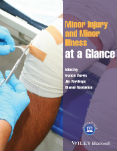-
1. Which of the following features would indicate need for a spine X-ray after trauma?
(a) Age >65 years
(b) Minor rear-end shunt
(c) Fall down five stairs
(d) Able to rotate neck 45° to left and right.
Show Answer
Correct answer:
(a) Age > 65 years and
(c) fall down five stairs
See Chapter 24.
-
2. Name the spinal roots tested by each of the following.
(a) Biceps reflex
(b) Supinator reflex
(c) Knee reflex
(d) Ankle reflex
Show Answer
Correct answer:
(a) Biceps reflex C5;
(b) Supinator reflex C6;
(c) Knee reflex L4;
(d) Ankle reflex L5, S1
See Chapter 24.
-
3. Name the dermatomes supplying each of the following.
(a) Middle finger.
(b) Outer aspect shoulder.
(c) Knee.
(d) Heel.
(e) Perianal area.
Show Answer
Correct answer:
(a) Middle finger C7;
(b) Outer aspect shoulder C5;
(c) Knee L3 – you kneel on L3;
(d) Heel S1 – you stand on S1;
(e) Perianal area S2, S3
See Chapter 24.
-
4. Outline the ABCS of spinal X-rays.
Show Answer
Correct answer:
A, adequacy and alignment
B, bones
C, cartilage – disc spaces
S, soft tissues
See Chapter 24.
-
5. Which patients do NOT require an X-ray after a minor rear-end shunt?
Show Answer
Correct answer:
- No high risk factors
- Not a dangerous mechanism
- Age less than 65 years
- No paraesthesia/weakness
- Able to rotate neck to 45° to right and left
See Chapter 25.
-
6. What is the treatment for a neck sprain (whiplash)?
Show Answer
Correct answer:
- Simple analgesia
- Local heat
- Movement and exercise
See Chapter 25.
-
7. A young woman wakes up with bad neck pain and stiffness: what is the likely diagnosis and treatment?
Show Answer
Correct answer:
- Acute torticollis
- Analgesia
- Movement/exercise
- Short course of diazepam
See Chapter 25.
-
8. Outline the steps for examination of low back pain.
Show Answer
Correct answer:
- Spine – look/feel/move
- Neurological exam – power/tone/sensation
- Straight leg raising/sciatic nerve stretch tests
- Abdomen – especially in the elderly
- Pulses
See Chapter 26.
-
9. List five of the ‘red flags’ for back pain.
Show Answer
Correct answer:
- History of major trauma (or minor trauma in the elderly)
- Extremes of age (<20 or >55)
- Systemic symptoms (weight loss, fevers, chills)
- History of malignancy
- Night pain
- Intravenous drug use
- Immunocompromised (HIV, chemotherapy, etc.)
- Chronic steroid use
- Significant/progressive neurological signs
- Bladder or bowel dysfunction
See Chapter 26.

